Today I saw an interesting presentation of the current status of Defi development on PANews, so I will summarize the current status of Defi based on the article, and put the quotation at the end.
First of all, I would like to say that decentralized finance (DeFi) is the mainstream of future finance. Although the current market is still dominated by centralized exchanges (CEX), this is an inevitable part of the growth of DeFi. In the future, decentralized trading platforms will become the main tools used by people in daily life, while CEX will continue to exist as a supplement.
The rise of a decentralized thing often requires the help of some kind of "evil force" to survive and find attachment in the early days. For example, when the picture function was first launched in the early days of the Internet, the highest search volume was not landscape pictures, but pornographic content; a large number of transactions in the early days of Bitcoin also came from illegal transactions such as the gray market. But looking back, these "evil forces" did not define their future. The porn industry still exists on the Internet, but it is no longer mainstream; illegal Bitcoin transactions now only account for 3%-5% of the total.
Survive first, then have the opportunity to grow.
The original intention of DeFi was to get rid of dependence and trust in financial intermediaries, but in the process of development, it relied on the centralized system in turn. This contradiction may be the price of growth. As Professor Xu Yuan of Peking University said in "The Boundary of Currency", traditional finance is the dragon, and Bitcoin is the boy who slays the dragon: "If Bitcoin is compared to a dragon slayer, then this boy did not kill the dragon. On the contrary, the boy's butcher knife is already in the hands of the dragon, and even the dragon slayer himself has jumped into the dragon's arms without any hesitation." At least I believe that the current reluctance to welcome is for the purpose of standing tall tomorrow. Back to the current situation of Defi, we often use TVL to measure the data of Defi's strength. TVL: Total Value Locked, locked value.
Since it is a lock-up, what needs to be locked?
1. Stablecoin protocol
Stablecoin protocols represented by DAI usually adopt an over-collateralization mechanism: users lock their own encrypted assets (such as ETH) in smart contracts as collateral, and mint stablecoins (such as DAI) anchored to the US dollar at a certain collateral rate. In essence, this is a mortgage lending behavior, and collateral is also a lock-up.
2. Decentralized Exchanges
In decentralized exchanges, users deposit liquidity funds (such as various currencies) to exchange currencies and earn fees.
3. Derivatives and leveraged trading protocols
Traders deposit funds as margin to provide leveraged trading. The TVL here refers to the assets locked in the margin pool.
4. Staking agreement
Users pledge assets to obtain interest or equity tokens. For example, Lido is a protocol of this type. It uses the current Ethereum network to maintain network security by locking users' tokens, participate in consensus and obtain rewards, and helps more users participate in the staking process. Staking is locking positions.
5. Lending platform
Depositors such as aave or compound pledge assets to earn interest, and borrowers pledge assets in exchange for liquidity.
6. Yield Aggregator
Users entrust their assets to the protocol, and the protocol helps find the best yield strategy. This category includes Yearn Finance, etc.
After so much introduction, let's take a look at the picture.

The total locked value TVL of the entire network has reached 101.7 billion US dollars. Now the total cryptocurrency market value has reached 302 billion US dollars, and the proportion of TVL is 3.37%, which is still relatively small in terms of value. This is mainly because the value of Bitcoin cannot contribute to TVL.
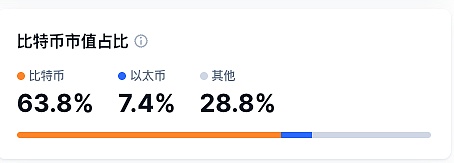
This is an analysis of the current market value of cryptocurrencies. Bitcoin, which accounts for 63.8% of the market value, can actually do little to help the growth of TVL. The reason for this is structural. On the one hand, the Bitcoin chain does not support smart contracts. On the other hand, most of the core assets of Defi are ETH as the main circulation method, and BTC is passively held. Although Bitcoin also has Defi, it is mainly implemented off-chain or cross-chain. Therefore, this limitation makes the current growth of TVL have a ceiling.
At the same time, the TVL of Aave and Lido reached 34.5 billion US dollars, which means that more than 37% of Defi TVL is ETH pledged in Aave and Lido. Most DeFi happens on Ethereum, proving it is still the most important blockchain.
The market cap of stablecoins has reached $236 billion, accounting for more than 8.3% of the crypto market. In this report, the author said:
"Stablecoins account for more than 8.3% of the $2.8 trillion crypto market, more than twice that of DeFi. The growth rate of stablecoins continues to exceed DeFi TVL, indicating that it has truly achieved product-market fit."
This comparison is not very meaningful. DeFi's TVL also includes the market cap of many stablecoins. For example, the TVL of a decentralized exchange requires you to stake a trading pair such as ETH/USDT, and you need to stake both tokens.
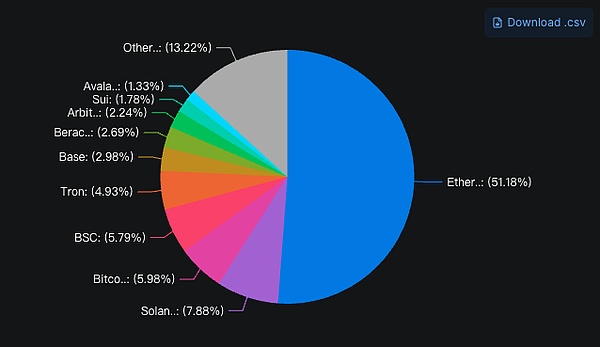
"Currently Ethereum is still the most important player in DeFi, accounting for 52% of TVL, but it has dropped from 58.3% last year. Solana has become the second largest competitor with 8% TVL, but it is still more than 6 times smaller than Ethereum."
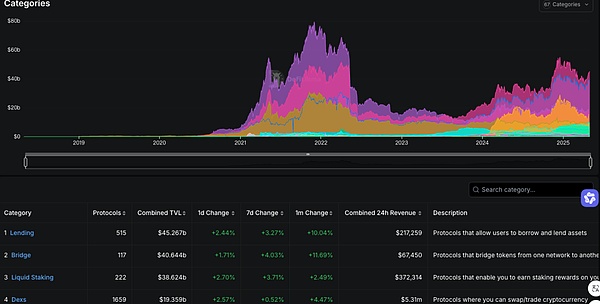
"Lending, cross-chain bridges, and liquidity staking have the highest TVL, and the gap between them is relatively small, at 420. "Most players park their funds in Lido to earn returns, probably because most people are confident in ETH as a long-term store of value, and Lido also dominates in liquidity staking. Other ETH-based liquidity staking protocols also dominate, such as ether.fi. ”
“Sky Lending is the number one low-risk stablecoin option by TVL, with over $2.5 billion held in its SUSDS stablecoin and a 4.5% yield.”
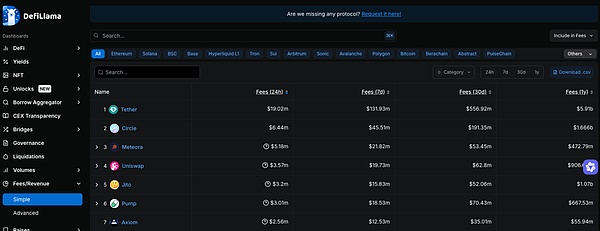
“Tether and Circle’s respective stablecoins are by far the largest fee-generating businesses in crypto. Tether alone has generated over $5.8 billion in revenue over the past year. “
”Solana’s fee ecosystem has grown the fastest over the past year, with Jito, Raydium, and Pump.fun all earning huge fees. This is likely mainly due to the sharp growth of memecoin on Solana. “
”Bitcoin’s fees have fallen by about half since last year, and Bitcoin’s ranking has fallen from second to 14th place as many other competitors in the fee market have risen. ”
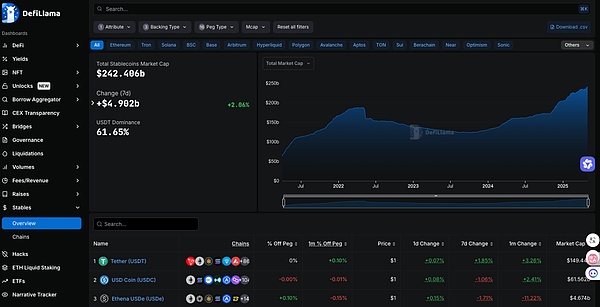
“The total market capitalization of stablecoins has almost doubled, from $136 billion last year to $235 billion now. However, USDT and USDC still dominate, accounting for 62% and 26% respectively, and a total of 88% of the entire market.
The biggest growth was in Ethena’s USDe, which, despite not being launched a year ago, is now the third largest stablecoin with a 2% market share.
Sky issued the USDS token, breaking DAI's dominance. However, after combining the market capitalization of DAI and USDS, Sky has a 3.5% market share and is still the third largest market player.
USDT, USDC, DAI/USDS and USDe together account for about 93% of the stablecoin market, with a market capitalization of more than $220 billion. ”
Don’t just look at the fact that USDT only accounts for 62% of the market share and think that it is just more than half. USDT’s penetration and channel capabilities are really too strong.
I have a friend who is starting an artificial intelligence business. He needs to reward promoters in Africa, and the other party directly stated that he only wants USDT.
The power of channels should not be underestimated. You may see a variety of beverage brands emerging in first-tier cities, but in small shops in fourth- and fifth-tier cities, you can often only see brands such as Wahaha and Nongfu Spring. It is this in-depth and extensive channel layout that has supported the founders of Nongfu Spring, Zhong Shanshan, and Wahaha, Zong Qinghou, to ascend to the throne of China’s richest man many times.
That's all for today, Defi is the general trend.
 Catherine
Catherine











